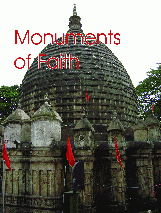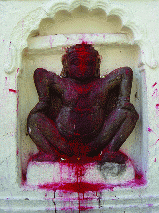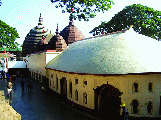Monuments of Faith
Monuments of Faith
For thousands of years, religious decree barred women from entering temples and chanting or listening to  mantras. This was scripted by Manu, the mythological ancestor of the human race in Hinduism. However, the worship of a living woman as Goddess Shakti has been in practiced from time immemorial. Manu’s 5,000 year old law has been challenged over and over again as the one worshipped is herself a woman.
During the month of June or July,the annual festival known as the Ambuvaci attracts thousands of devotees from all over the country. In this part of the country Shakti is worshipped as goddess Kamakhya. In this 4-day festival more than 100,000 pilgrims visit the Kamakhya temple situated in the Neelachal Parbat or Kamagiri in the city of Guwahati.
This year the festival commenced on the 22nd of the month.
mantras. This was scripted by Manu, the mythological ancestor of the human race in Hinduism. However, the worship of a living woman as Goddess Shakti has been in practiced from time immemorial. Manu’s 5,000 year old law has been challenged over and over again as the one worshipped is herself a woman.
During the month of June or July,the annual festival known as the Ambuvaci attracts thousands of devotees from all over the country. In this part of the country Shakti is worshipped as goddess Kamakhya. In this 4-day festival more than 100,000 pilgrims visit the Kamakhya temple situated in the Neelachal Parbat or Kamagiri in the city of Guwahati.
This year the festival commenced on the 22nd of the month.
One of the most persistent mythologies concerning the origin of worship at the site is associated with the myth of Sati, who was the wife of the ascetic god Shiva and daughter of the Puranic god-king Daksha. Daksha was unhappy with his daughter’s choice of a husband, and when he performed a grand Vedic sacrifice for all the deities, he did not invite Shiva or Sati.  In a rage, Sati threw herself onto the fire, knowing that this would make the sacrifice impure. Because she was the all-powerful mother goddess, Sati left her body in that moment to be reborn as the goddess Parvati. Meanwhile, Shiva was striken with grief and rage at the loss of his wife. He put Sati’s body over his shoulder and began his tandava also known as the dance of cosmic destruction throughout the heavens, and vowed not to stop until the body was completely rotted away. The other Gods, afraid of their annihilation, implored Vishnu to pacify Shiva.
In a rage, Sati threw herself onto the fire, knowing that this would make the sacrifice impure. Because she was the all-powerful mother goddess, Sati left her body in that moment to be reborn as the goddess Parvati. Meanwhile, Shiva was striken with grief and rage at the loss of his wife. He put Sati’s body over his shoulder and began his tandava also known as the dance of cosmic destruction throughout the heavens, and vowed not to stop until the body was completely rotted away. The other Gods, afraid of their annihilation, implored Vishnu to pacify Shiva.
Thus, wherever Shiva wandered while dancing, Vishnu followed. He dared not come close to the terrible Shiva, so he sent his discus Sudarshana to destroy the corpse of Sati. Pieces of her body fell until Shiva was left without a body to carry. Seeing this, Shiva sat down to do great penance.
According to various myths and traditions, there are 51 pieces of Sati’s body scattered across the Indian subcontinent. These places are called shakti peethas and are dedicated to various powerful goddesses.
Kamarupa is the region in which the yoni also considered the “womb,” is said to have fallen to earth, and the Kamakhya temple was said to have been constructed on this spot.
Being the centre for Tantra worship this temple attracts thousands of Tantra devotees in the annual festival of Ambuvaci. During the Ambuvaci festival each summer,the menstruation of the Goddess Kamakhya is celebrated. At this time, the water in the main shrine runs red with iron oxide resembling menstrual fluid.
Ambuvaci. During the Ambuvaci festival each summer,the menstruation of the Goddess Kamakhya is celebrated. At this time, the water in the main shrine runs red with iron oxide resembling menstrual fluid.
Kamakhya is often synonymous with Shakta Tantra. Tantric worship of Kamakhya is very secretive in nature. Tantric texts such as the 10th century Kalikapurana and 15th century Yoginitantra suggest that worship of this goddess is radically non-dual in nature and of the vamachara, or “left-hand path,” which includes the use of forbidden substances such as panchamakara and practices designed to transcend desire and personal ego. Features of Tantric worship may include the drawing of a yantra with sindoor and repeating the bija mantra associated with her. However, common worship of this goddess is fairly orthodox in nature. The Kalikapurana states that all worship is acceptable to the Goddess, and that one should worship her according to one’s own customs. Worship of Kamakhya grants moksha, or ultimate spiritual liberation.
The unconventional form of Darshan at this temple astonishes the pilgrims from around the world. Here Darshsn is not performed by sight as in most temples, but by touch.
Within the temple there is a cave, in a corner of which stands a block of stone on which the symbol of Yoni has been sculptured. The stone is kept moist from the oozings of a natural spring within the cave. The offerings of flowers and leaves are made to the Yoni. In other respects the daily rites and ceremonies are those of the Goddess Kali with sacrifices of various animals. Ordinarily, the females of all animals are exempted from sacrifice..gif) Because the goddess Kamakhya is worshipped in the symbol of a Yoni, it has often been held that the cult of the Yoni sprang up first in Assam and then spread over the rest of India. But the sensual Tantric forms of Yoni worship owe their origin to Kamakhya worship. The two principal Sanskrit works that bear upon the subject are the Kalika Purana and the Yogini Tantra, both composed in or near about ancient Assam.
Because the goddess Kamakhya is worshipped in the symbol of a Yoni, it has often been held that the cult of the Yoni sprang up first in Assam and then spread over the rest of India. But the sensual Tantric forms of Yoni worship owe their origin to Kamakhya worship. The two principal Sanskrit works that bear upon the subject are the Kalika Purana and the Yogini Tantra, both composed in or near about ancient Assam.
The name of the hillock where the shrine stands is Nilachala. According to the. Kalika Purana the genital organ of Sati fell here when her dead body was carried hither and thither in frantic sorrow by her husband Shiva. The mountain represented the body of Shiva and when Sati’s genital organ fell on it, the mountain turned blue. The Goddess herself is called Kamakhya, because she came there secretly to satisfy her amour with him. Thus the derivations of the Kalika Purana make the mountain both a graveyard and a scene of the secret love-tryst of the Goddess.
If the Kalika Purana gives an amorous interpretation of the origin of the Yoni-Goddess, the Yogini Tantra takes no notice of the myth and gives a different account, stressing the creative symbolism of the Yoni. In answer to a query by the Devi as to who Kamakhya was, Shiva replies that Kamakhya is the same as Kali, the eternal in the form of Brahma. Then Shiva tells the story about the origin of Kamakhya.
In primeval times, Brahma after having created the universe arrogated to himself the supreme creative force. The Goddess noticed this arrogance of Brahma and created out of her own body a demon named Kesi. As soon as born, the demon rushed towards Brahma to swallow him up. Brahma fled in terror in the company of Vishnu. The demon then built a city called Kesipura and began to harass the three worlds. There was all around the echo of a sound, “Kill Brahma.” Brahma cast aside his vanity and in the company of Vishnu offered a hymn of propitiation to Kali for the relief of the worlds from the tyranny of Kesi. The Goddess was satisfied and confessed that the demon was her creation for the punishment of Brahma for his arrogant ignorance. She then uttered the syllable of destruction and burnt up the demon to ashes. Then she gave directions to Brahma for his deliverance from the sin of arrogance and ignorance. Brahma was to create a mountain out of the ashes of the burnt demon. The mountain should not be too high nor too low. It should be covered over with edible grass for cattle. Brahma’s sin would be diminished in proportion to the quantity of grass consumed by the cattle. She went on further to say that on the spot wherefrom they had offered her prayers for the destruction of the demon there was springing up, in their very presence, a Yoni circle out of her own creative energy and it should be regarded as the source and origin of all things. In future Brahma should create after having contemplated the Yoni. But just then Brahma was debarred from seeing the Yoni until, by his penance and purification, he had brought down a luminous light from the sky and placed it on the Yoni circle. For his good as well as for the good of the world, she had created the Yoni circle and placed it in Kamarupa. Brahma accordingly created a mountain by sprinkling holy water from his jug and called it Govardhana and also planted a Tulasi grove and called it Vrinda-Vana according to Goddess Kali’s direction.
Thus the two scriptures put divergent interpretations about the Yoni circle as a symbol of sex and as a symbol of creation. These may embody the views of two different sets of people in different periods of time.
The original Kamakhya temple was destroyed during the Muslim invasion early in the sixteenth century. The current temple structure was constructed in 1565 by Chilarai of the Koch dynasty in the style of medieval temples. The form of the earlier structure, destroyed by the Kala Pahar, is unknown. The current structure has a bee-hive like shikara with delightful sculptured panels and images of Ganesha and other Hindu Gods and Goddesses on the outside.
According to a legend the Bihar royal family was banned by Devi herself from offering puja at the temple. In fear of this curse, to this day no descendant of that family dares to even look upward towards the Kamakhya hill while passing by.
Without the support of the Koch royal family the temple faced alot of hardship. By the end of 1658, the Ahoms under king Jayadhvaj Singha had conquered Lower Assam and their interests in the temple grew. In the decades that followed the Ahom kings, all who were either devout Shakta continued to support the temple by rebuilding and renovating it.
Rudra Singh was a devout Hindu and as he grew older he decided to formally embrace the religion and become an orthodox Hindu by being initiated or taking sharan of a Guru, who would teach him the mantras and become his spiritual guide. But, he could not bear the thought of humbling himself in front a Brahmin who was his subject. He therefore sent envoys to Bengal and summoned Krishnaram Bhattacharyya, a famous mahant of the Shakta sect who lived in Malipota, near Santipur in Nadia District.The mahant was unwilling to come, but consented on being promised to be given the care of the Kamakhya temple. Though the king did not take sharan, he satisfied the mahant by ordering his sons and the Brahmins in his entourage to accept him as their spiritual guru.
When Rudra Singha died, his eldest son Shib Shinha who became the king, gave the management of the Kamakhya temple and along with it large areas of land to Mahant Krishnaram Bhattacharyya. The Mahant and his successors came to be known as Parbatiya Gosains, as they resided on top of the Nilachal hill. Many Kamakhya priests and modern Saktas of Assam are either disciples or descendants of the Parbatiya Gosains, or of the Nati and Na Gosains.
The fusion of faiths and practices in the region of Kamprup with the unusual style of deity worship challenges the wrongly dubbed claim of women not worthy of entering temples and chanting or listening to mantras. The worship of this female Kamakhya grants moksha, or ultimate spiritual liberation.
Ankita Purkayastha


